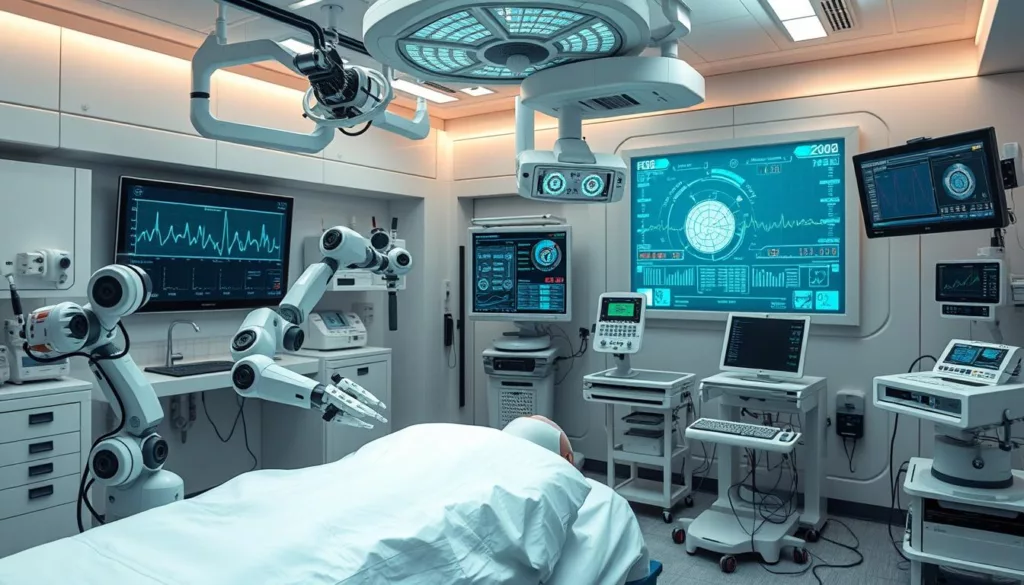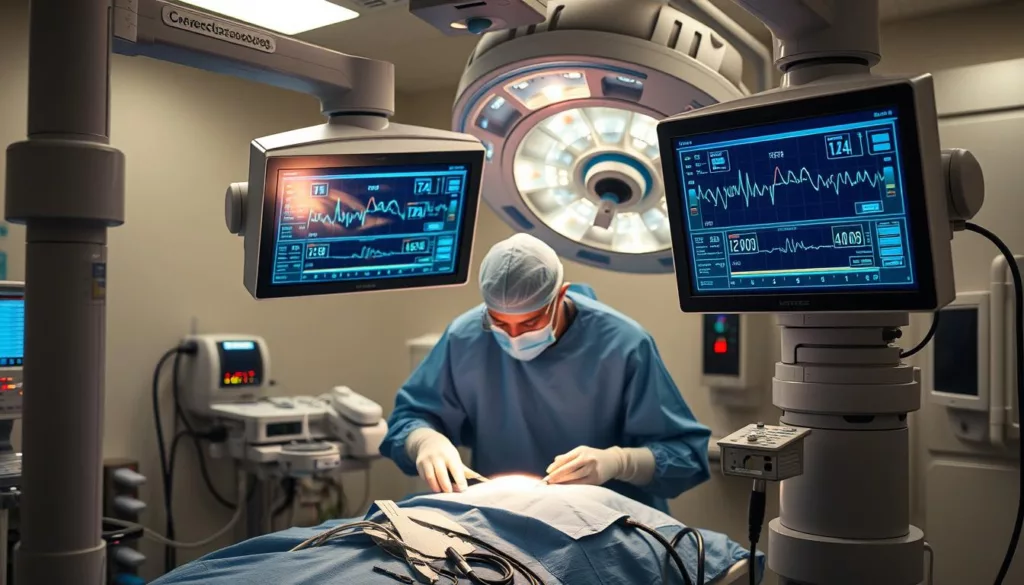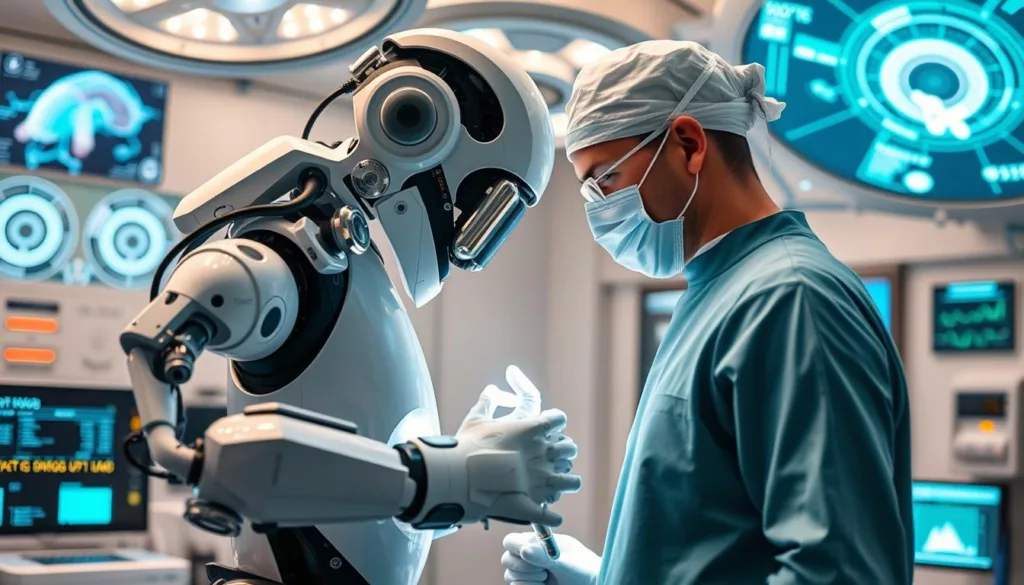In today’s healthcare, technology and patient care are merging, thanks to medical robotics. Sensors in medical robotics bring many benefits. They improve surgical precision, enhance patient safety, and allow for real-time data monitoring. At XJCSENSOR, we focus on providing top-notch sensory solutions for the medical field’s growth.
This article dives into the many advantages of medical sensor technology. It shows how it changes robotic surgeries for the better.
Key Takeaways
- Medical sensor technology enhances surgical precision.
- Robotic surgeries improve patient safety through real-time monitoring.
- Sensors facilitate accurate data collection during procedures.
- Integration of sensors leads to more efficient healthcare outcomes.
- Technological advancements are continually evolving medical robotics.
Introduction to Medical Robotics
Medical robotics is changing surgery with new technology. It makes surgeries less invasive and more efficient. This is thanks to robotic surgery and surgical robotics technology. This technology includes robotic arms and high-definition cameras.
Sensors play a big role in these systems. They help with precise movements and give feedback during surgery. This makes surgeries more accurate and improves patient care. Exploring medical robotics shows how it’s changing healthcare.
To learn more about force sensors in robotics, visit this page on force sensor technology. Real-time data helps improve surgery, making it smoother in hospitals.
Understanding Sensor Technology
Sensor technology is key in medical robotics, providing vital data for surgeries. Different types of sensors are used for various tasks. They help in many ways, like:
- Optical Sensors: Detect light patterns to assist in navigation and imaging.
- Ultrasonic Sensors: Measure distance and assist in real-time positioning.
- Pressure Sensors: Monitor forces applied during surgical procedures.
Each sensor type has its own role. For example, optical sensors help with precise movements. Ultrasound technology maps out tissue density. These sensors make surgeries safer and more effective.
At XJCSENSOR, we understand how important these sensors are. We create top-notch solutions for healthcare professionals. Our advanced sensors help make surgeries better, leading to better patient care.
Benefits of Using Sensors in Medical Robotics
Sensors in medical robotics have changed surgery for the better. They bring big benefits to both doctors and patients. This leads to better results and more efficient surgeries.
Enhanced Surgical Precision
Sensors help doctors do surgeries with more accuracy. This means fewer mistakes and quicker healing for patients. They give feedback during surgery, helping doctors stay on track.
Real-time Data Monitoring
Monitoring data in real-time changes surgery. Doctors can see how the patient is doing and adjust as needed. This makes surgery safer and more effective.
| Benefit | Description |
|---|---|
| Enhanced Surgical Precision | Improvement in accuracy during complex surgeries, leading to fewer complications. |
| Real-time Data Monitoring | Instant availability of critical patient data allows for on-the-spot adjustments during surgery. |
| Improved Outcomes | Faster recovery times and overall better patient health outcomes. |
| Increased Surgeon Confidence | Surgeons can rely on precise data, boosting their confidence in procedures. |
Types of Sensors Used in Medical Robotics
In medical robotics, knowing about different sensors is key. They help improve patient care and surgery results. There are mainly two types: sensors for vital signs and those for tracking surgical tools. Both are vital for safe and efficient surgeries.
Patient Vital Sign Monitoring Sensors
These sensors give real-time health data of patients. They track heart rate, blood pressure, and oxygen levels. This helps doctors make better decisions and keep an eye on patient health during surgery.
Surgical Instrument Tracking Sensors
These sensors make surgeries safer and more efficient. They track where and how surgical tools are used. This reduces the chance of mistakes and ensures tools are used right and found after surgery.
Using both types of sensors together makes a better monitoring system. It improves surgery accuracy and safety. For more on sensor technology, check out XJCSENSOR, a top name in robotic sensors.
| Sensor Type | Primary Function | Benefits |
|---|---|---|
| Patient Vital Sign Monitoring Sensors | Tracks physiological metrics | Provides real-time health information |
| Surgical Instrument Tracking Sensors | Monitors surgical instrument usage | Reduces risks of instrument misplacement |
Impact on Patient Safety in Robotic Surgery
In robotic surgery, keeping patients safe is key. Advanced sensors play a big role here. They help by watching over patients in real-time and giving feedback.
This means surgeons can keep a close eye on patients’ health. They can act fast if something goes wrong. Sensors help avoid mistakes and keep patients safe.
Using top-notch healthcare technology raises the bar for patient care. For example, XJCSENSOR’s robotic systems offer unmatched precision. This builds trust in robotic surgery for complex cases.
| Feature | Impact on Patient Safety |
|---|---|
| Real-time Monitoring | Immediate detection of complications and urgency in response |
| Feedback Systems | Reduction of accidental surgical errors and increased confidence |
| Data Accuracy | Enhanced decision-making backed by reliable patient data |
| Sensor Adaptability | Customizable systems for various surgical environments |
Sensors in robotic surgery boost safety and effectiveness. With healthcare technology getting better, robotic surgery’s future looks bright and safe.
Real-time Surgical Data Monitoring and Its Importance
Real-time surgical data monitoring is key in modern medical robotics. It gives surgeons important insights during operations. This technology greatly improves workflow and outcomes.
Improved Decision-making
Surgeons get precise and relevant patient data in real-time. This helps them make better decisions quickly. They can adjust their approach as needed.
This access to data helps surgeons make more informed decisions. It improves patient care.
Reducing Human Error
Real-time data monitoring helps reduce errors in surgery. It provides a steady flow of accurate data. This reduces mistakes caused by miscommunication or oversight.
With this technology, surgeries become safer. It builds confidence among medical teams and patients.
Sensor-guided Robotic Surgery Enhancements
Sensor-guided robotic surgery is a big leap forward in medicine. Recent robotic surgery advancements have made a big difference. Now, doctors can do minimally invasive surgeries with much more precision.
These improvements bring many benefits:
- Greater control over surgical instruments
- Improved adaptability during procedures
- Reduced invasiveness, leading to shorter recovery times
- Enhanced overall patient experiences
Thanks to these new tools, sensor-guided robotic surgery is changing the game. It shows the power of surgical innovation. It also helps doctors do their jobs better and makes surgeries safer.
| Advancements | Benefits |
|---|---|
| Enhanced Control | Allows for detailed procedures with less damage |
| Real-time Feedback | Helps doctors make quick changes during surgery |
| Data Integration | Supports detailed patient monitoring and assessment |
| Reduced Recovery Time | Patients can get back to normal faster |
Medical Robotics Optimization with Sensory Feedback
The use of sensory feedback systems is a big step forward in medical robotics. These systems give real-time data and help control robotic movements better. This makes surgeries more efficient.
Surgeons get important information from these systems. This helps them make better decisions during surgery. It leads to better results.
Companies like XJCSENSOR are making new force sensing solutions for medicine. These technologies will help make surgery better and safer.
- Enhanced control for improved outcomes
- Real-time adjustments increase surgical precision
- Integration with advanced robotics promotes safety
Thanks to sensory feedback systems, surgeries are getting better. They are faster and safer. The future of surgery looks bright with these technologies.
| Key Features | Benefits |
|---|---|
| Real-time Data | Facilitates immediate adjustments during surgery |
| Precision Control | Increases surgical accuracy and reduces errors |
| Integration with Robotics | Enhances overall performance and reliability |
Case Studies: Successful Implementations
Looking at case studies in robotic surgery shows how sensor technology changes healthcare. Hospitals using this tech have seen big improvements. Patients are also happier with their robotic surgery experiences.
Notable Hospitals and Their Achievements
Top hospitals have started using new sensor systems. They’ve seen big wins in surgery. These wins have also made patients trust robotic surgery more. Here are some key results:
| Hospital Name | Type of Robotic Surgery | Complication Rate (%) | Average Recovery Time (Days) |
|---|---|---|---|
| Johns Hopkins Hospital | Urological Surgery | 1.2 | 2 |
| Cleveland Clinic | Cardiac Surgery | 1.5 | 3 |
| Mayo Clinic | Orthopedic Surgery | 0.8 | 1.5 |
Patient Testimonials on Robotic Surgery
Patients talk about how well robotic surgery works. They say they’re happy and feel little pain:
- “The recovery was quick, and I felt cared for every step of the way.”
- “I appreciated the precision of the robotic surgery. It made a significant difference in my journey to recovery.”
- “Being able to go home the next day was astonishing. I’m grateful for the innovative care.”
Future of Sensors in Medical Robotics
The world of medical robotics is set for a big change. This is thanks to new advancements in sensor technology. These changes will make surgeries more precise and effective.
Robotic surgery is getting smarter, thanks to better sensors. These smart systems can react to feedback in real time. This means better care for patients.
- Integration of AI and machine learning with sensor data for enhanced diagnostics.
- Development of smaller, more efficient sensors that provide greater accuracy.
- Increased use of wearable sensors for continuous patient monitoring before, during, and after surgeries.
Working together, tech companies and healthcare will bring new sensor ideas. We’re excited for the future. It will make sure patients are safe and get the best care possible.
| Advancement in Sensor Technology | Expected Outcome |
|---|---|
| Miniaturization of sensors | Enhanced precision in surgical instruments |
| Integration of smart algorithms | Improved patient monitoring and data analysis |
| Remote sensing technologies | Better access to real-time patient data |
Challenges and Limitations of Medical Sensor Technology
Using sensors in medical robots is a big step forward. But, there are big challenges in medical sensors. One major issue is the high cost of these advanced sensors. This makes it hard for many hospitals to afford them.
Another problem is making these new sensors work with old systems. It’s not easy to make sure they fit together right. If they don’t, it can lead to bad results and even danger for patients.
Here’s a quick look at the main problems with sensor technology in medicine:
- High Costs: Advanced sensors can be very expensive for hospitals.
- Integration Issues: Adding new sensors to old systems is hard and takes a lot of time.
- Malfunction Risks: Sensors can fail or give wrong information, which is dangerous for patients.
- Regulatory Compliance: Following strict rules can slow down the use of new sensors in medicine.
To solve these problems, we need more research and teamwork. Engineers, doctors, and rule-makers must work together. By tackling these issues, we can make robotic surgery better and safer for everyone.
| Challenge | Impact |
|---|---|
| High Costs | Restricts accessibility for medical facilities |
| Integration Issues | Delays implementation and increases risks |
| Malfunction Risks | Potential safety hazards during surgeries |
| Regulatory Compliance | Slows innovation and market entry |
Conclusion
The use of sensors in medical robotics has made a big leap forward. It has brought many benefits, like better surgical precision and safer patient care. It also allows for real-time data monitoring, changing how we do robotic surgeries.
This change has made surgeries better and shows our dedication to caring for patients. Looking ahead, the role of sensor technology in medical robotics will grow even more. At XJCSENSOR, we see a lot of room for new ideas in this area.
Working together, engineers, healthcare experts, and sensor makers will create even better solutions. These solutions will focus on being both accurate and efficient. This teamwork will help us achieve new heights in surgical excellence.
The future holds many chances to make surgeries even better. By using sensors in medical robotics, we can make healthcare better for everyone. Together, we can face challenges and show what robotic surgery can really do.






